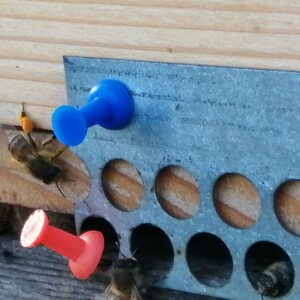Forward Thinking
I’ve had my eye on this winter honeysuckle for a while, and very pleased to see it produce its first flower today – this is the plant’s first winter, planted on the north side of a house and fence, in extremely poor land, so I was not expecting much, and this is cheering. They are supposed to be fragrant, but I’m not getting much from a single flower yet. They are also supposed to be attractive to bees, if they get the weather to fly in Feb/Mar – part of the reason we planted it. So that is my excuse for an extra with bees from our nearby second apiary.
I’m not pretending the pollen on the hind leg of the bee on the left of the extra is from this flower – I think the garden of the nearby farmhouse is much more likely. She is about to enter the hive entrance with her load; the portcullis entrance is a ‘mouse guard’, designed to let bees pass through, but exclude any mice that might think a warm beehive with plenty of honey is preferable to another winter night under the hedge. The guard does make it a bit more difficult for the bees to go in and out – and in particular to drag out corpses like the one poking its head out of the hole on the right. A mouse guard may also sometimes knock pollen pellets off the bees’ legs when they enter – wasting all that collecting effort – but it is still preferable to have them in place over winter, and avoid the unpleasant business of an unsanitary mouse in the hive
Plucky bees to be flying at all today. It’s been sunny, but the hives were in shade and the wind quite sharp. After five minutes watching comings and goings, in a thick shirt and a thick cotton bee-top, I was chilly enough to be pleased to move on. I doubt if the thermometer hit double figures. The fact that they are fetching pollen suggests that there are plenty of them still there, so they are not worried about losing some heat by foraging. It also implies that they have some use for fresh pollen that makes the effort worthwhile, which in turn suggests they are actively rearing new young larvae, who need the pollen as a protein source
New young bees will keep up the colony size, but that means I must make sure they are not short of carbohydrate: their own honey, supplemented by sugar fondant that we will provide as a ‘just in case’ back-up. March is the danger month, especially if the weather turns nasty (and it can’t stay like this for ever!) Growing colonies, egged on to expand their numbers by a warm spell like this in February, can run out of feed in March very quickly. So, cautious optimism, but full focus required


Comments
Sign in or get an account to comment.


